What does Taurus look like?
Taurus is a wonderful constellation, one of my favourites, alongside Orion and Cassiopeia. The area of sky is rich in interesting celestial objects, so this one's going to be a pleasure to investigate.In most depictions of Taurus, unlike many other animal constellations, only the front half of the bull is often shown:
With the picture taken out, we are left with this basic shape for the constellation, the shoulders, head and horns of the bull:
| (image: Enchanted Learning) |
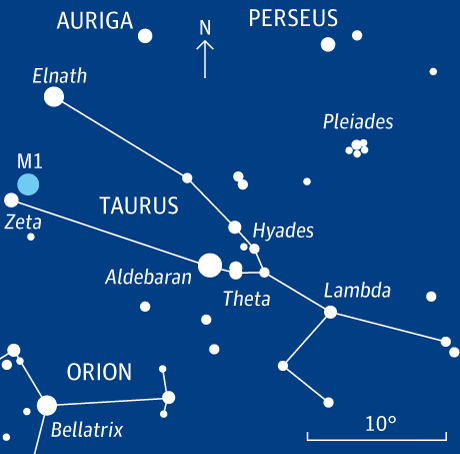 |
| (Image: Finbarr Sheeh, The Guardian) |
So, how do you find Taurus?
Taurus is very visible in the northern sky in the winter months. Since we already know how to find Orion and Gemini, finding Taurus is relatively simple. Though Orion is often shown as holding the body/pelt of a lion, in the sky he stands with his sword and shield raised towards the bull. There are some very bright and distinctive stars in the head of Taurus. |
| (image: EAAE) |
 |
| (image: One Minute Astronomer) |
What are the main stars in Taurus?
The most well-known star in Taurus is Aldebaran. Some others of note are: El Hecka, El Nath, Atlas, Hyadum I and Hyadum II, Ain, Alcyone to name a few; the latter being one of the brightest of the star cluster Pleiades, several of the others belonging to the star cluster Hyades. We'll start with the brightest.
Aldebaran
The main star in Taurus, standing out in the sky, is the bull's fiery eye, Aldebaran (from "Al Dabaran" meaning 'the follower', in Arabic, named thus because it rises soon after the star cluster Pleiades). It's also called 'The Eye of Taurus' . You can find it by following Orion's belt upwards, roughtly in the direction away from Canis Major: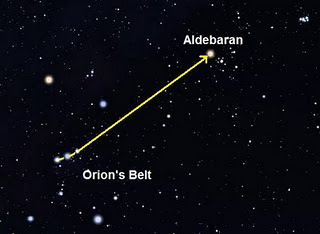 |
| (image: EarthSky- well worth a look at for all the info on Aldebaran) |
The brightest star in Taurus (Alpha(α) Tauri) 14th brightest star in the sky, and sitting on the route that most of the planets, the sun and moon follow in the sky - the ecliptic...
A quick word about the ecliptic. Taurus is one of the zodiac constellations because these celestial bodies 'pass through' this area of sky, shown by the red line on this image (by the way, because there's no 'up' and 'down' in space, and how the stars look in the sky depends on where in the world the image was taken, sometimes the image doesn't show them up the same way...sometimes they're even upside-down to what we're used to):
 |
| (image: Hudson Valley Geologist) |
 |
| (image: Startistics) |
Because of the tilt on Earth's axis, the Sun, Moon and planets rise and fall along a slanted path each night:
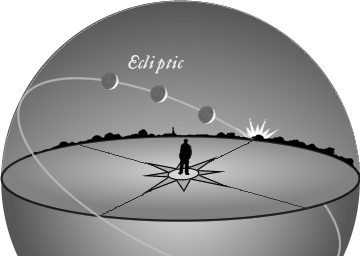 |
| (image: EarthSky) |
Now, back to Aldebaran. Many a novice star-watcher has mistaken Aldebaran for the planet Mars, because of it's deep red colour (see in this image how red the star is compared to Bellatrix and the other surrounding celestial bodies):
 |
|
by David Malin et al at his website! His image, on this page,
shows up all the constellations and other objects)
|
Here, in this image by John Cumack from Astronomy Picture of the Day, Mars is seen passing through Taurus. Mars is above and left of centre, Alderbaran is below and left of center...you can see how the two might be mistaken:
Aldeberan might be yet another binary star system. It sits about 65 light years away, an orange giant star about 38 times the size of the Sun. It is a very slowly pulsating giant star, its variation not visible with the human eye, which is no longer burning hydrogen in it's core, but is now fusing helium to such elements as carbon and oxygen. The other star is Alpha Tauri B, which is a red dwarf of about 15% of the size of our sun. Although some accept the B star as a physical binary, some think it might be simply an optical binary (ie the only relationship between the two stars is that they both sit in the same line of sight away from Earth).
Aldebaran seems to be part of the Hyades cluster of stars (which forms the V shape of the head of Taurus) but in fact sits in front of it 65 light years away, whereas the star cluster is about 150 light years away (more on the Hyades below):
For some interesting references in literature and film, take a look at this Wiki page.
El Nath
The beta star of the constellation is El Nath (or Elnath, Alnath, Nath) is unusual in that it has belonged to two different modern constellations. It is the tip of the horn of Taurus, but, until quite recently (1930), it was also considered the Gamma star of the adjoining constellation of Auriga. It's name, however, is the give-away. El Nath means the 'butting of horns' and Auriga, being a charioteer, has no horns...so it was decided that the star should stay with Taurus.So, what tidbits do we know about El Nath? It's a really, really luminous and hot blue-white star (about 700 times the luminosity of our sun!) but it doesn't take pride of place in the constellation because it's twice as far (130 ly) than Aldebaran (65 ly) (see the 'How far away are the stars in Taurus' below) so doesn't appear as bright.
It has a faint visual side-kick, but isn't actually a binary and, in literature, is mentioned in a Star Trek episode, with the crew landing on its second planet.
Hyadum I
The third brightest star (the gamma star) is Hyadum I, a big bright middle-aged yellow giant, that is no longer burning hydrogen in its core, but is now fusing helium to make higher atomic weight elements like carbon. Hyadum I is part of the Hyades cluster (see below) that forms the head of the bull, relatively close in the sky to Aldebaran. I like the Arabic name for it: Awwal al Dabaran, which means "the first follower of the Pleiades," and sounds very much, to me, like a drawled 'Aldebaran'!According to Jim Kaler, an oddity about Gamma Tauri is that, though it spins slowly, it emits 'highly excited X-ray emissions from iron, oxygen, and neon', which would be expected from a faster spinning star.
In literature/film, this is another star mentioned in Star Trek to have a planetary system, and has the pleasure of being close to the 'Cardassian' border. (At 150 odd light years away, technology would've had to have developed amazingly for the human race to be hanging around this area!)
Hyadum II
Like Hyadum I, Hyadum II is another of the Hyades cluster's four giants, and is also in the V of the bull's head. Called Eudora, one of the Hyades sisters (or the Pleiades' half sisters) from Greek mythology it's just a little dimmer than Hyadum I.I would call it Delta Tauri, which it is, but it is only one of three star systems in the Hayades cluster with the same 'designation' or name.
So the brightest of these, the one we can see with the naked eye, is called Delta-1 Tauri. Delta-1 Tauri is an orange giant, with two companions - one visually close, and the other apparently orbiting it. The other two Delta stars are Delta-2 Tauri (a white, main sequence dwarf) and Delta-3 Tauri (also called Cleeia/Kleeia - another of the Hyades sisters), which is a triple-star system, consisting of a white sub-giant and its faint binary, a little way from another dim star.
 |
| (original image: Jerry Lodriguss) |
Ain
Ain (or Epsilon Tauri/ ε Tau) is the fourth orange giant of the Hyades (also called Occulus Borealis, meaning 'Eye of the North'). It is also unusual in that it is an open cluster star with an exoplanet (a planet of another star system than our own Sun). The planet was discovered in 2007 is about 7 1/2 times that of our own Jupiter and orbits the star once about every 595 Earth days. This is Tyrogthekreeper's creation of the gas giant planet:The next star on the list is the zeta star, El Hecka, the tip of the other horn than El Nath:
El Hecka
El Hecka is one of the furthest main stars of the constellation. When thinking how Aludra, of Canis Major, is over 3000 ly away, and the main stars of Orion are much further, this isn't so far, but it is still about four times the distance of many of the stars of the Big Dipper.I like this description of the star from Constellation of Words, which explores the entymology (background) and symbolism of the constellations, almost as much as I like this image, which I haven't seen before:
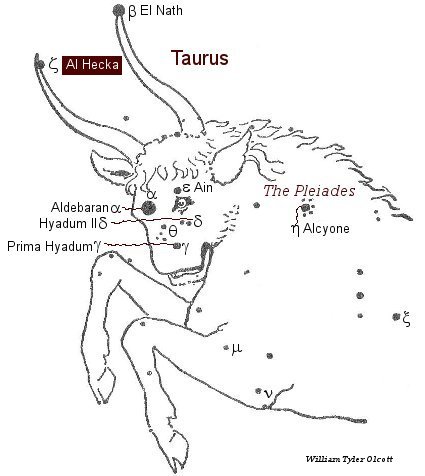 |
| (image: Constellations of Words) |
The bigger of the two stars is a Be star. We met one of these before in the constellation of Cassiopeia, I believe. Gamma Cassiopeia is one of the first recognised Be stars. A couple of the main characteristics of Be stars is their low ionisation 'emission lines' and the fact that they spin so that their gasses and outer layers float off and form a ring, or disc, around their middle, along with perhaps some sort of magnetic mechanism causing more ejections. It is this latter that causes the emission lines. They tend to be variable stars.
It's not certain what sort of star the companion is, only the mass and motion can be ascertained at this stage.
Atlas
Just a quick word about this Lamda ((λ) Tauri star, Atlas (originaly named Sadr al Tauri, which means the Bull's Chest). It is actually a triple star, of which two of the stars are an eclipsing binary. This means that those two stars orbit each other in the 'line of sight' (one in front of the other), blocking each other (or eclipsing each other) periodically. From this, their mass and orbits can be calculated. From this, it was discovered that two of the stars orbit each other in under 4 days...very close together, about a tenth of the distance between Earth and the Sun apart.These two stars are both giants - one a massive blue-white star, the other sub-giant, both spinning fast (and orbiting each other pretty fast compared to how fast even Mercury orbits the Sun!).
Then, around these two stars orbits another smaller star every 33 days, shaking the larger two stars just enough to be measured (it is described as 'perturbing' them).
Here's a great image of them from Der kleine Sternenreisende:
There are lots of other bright stars in Taurus, but I will cover some of these when I look at the two star clusters in the constellation:
What are the deep sky objects in Taurus?
Pleiades (M45)
(Also named Collinder 42)
 |
| (image: Startistics) |
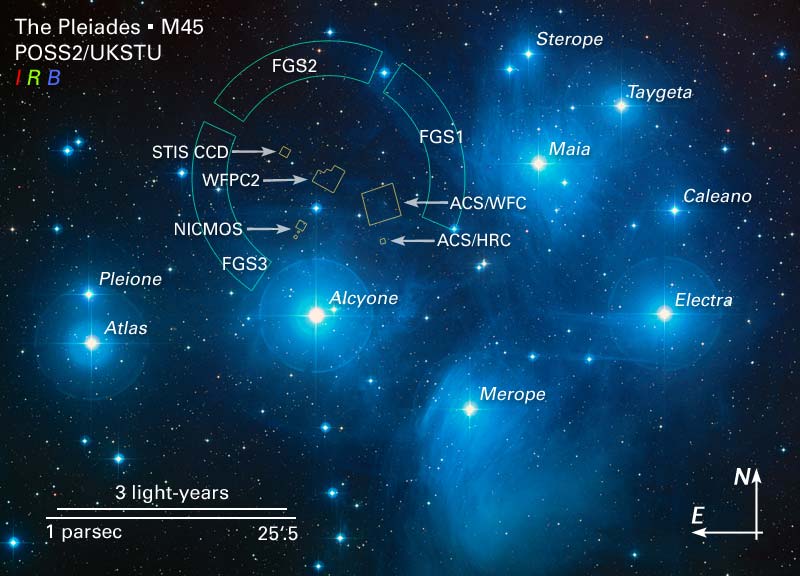 |
| (image: Wikipedia) |
Alcyone
One of brightest stars of the Pleiades, Alcyone is a hot blue-white giant and another Be star, which spins at the fast rate of 215 km per second! and has a gaseous disc around its equator. It will also have the low emission lines associated with Be stars. As might be expected, it is also a binary. In this case, an eclipsing binary, which means the stars orbit each other, periodically passing in front of each other. These two stars are about as far away from each other as the Sun and Jupiter. See here for other stars in the system.Hyades
(also named Collinder 50)
Since I've already covered the main stars in the star cluster, I'll just leave you with this image by Jerry Lodriguss (APOD) I used earlier, but without all the drawing on it:
One of the most wonderful objects in Taurus is the Crab Nebula:
The Crab Nebula
This is a supernova remnant from a star that exploded about a thousand years ago, in 1054 AD, and its was recorded by Chinese astronomers. It can be seen with a good pair of binoculars. You can see it near the bull's southern horn from this earlier image from Startistics:
When the star ran out of fuel to burn, and so the pressure outwards was exceeded by gravitational pressure, it would've imploded...until a point where the atomic particals were so condensed that they violently reacted with each other, blowing out much of the external material surrounding the core. This material has continued to expand in space over the last millenia, giving off a lot of x-rays and gamma rays.
See this YouTube video from ESA:
Because it was observed so long ago (and yet so recently in the history of the Universe) it is one of the longest observed supernova's.
Taurids meteor shower
(sometimes known as the Halloween fireballs, since they come at about the end of October)
The Taurids are not the best show of the year, but if you happen to be out and about, you might see a few more meteors than normal. This image is from Astronomy Central page listing, and describing, the meteor showers of 2014. The Taurids come from the Earth passing through the dust and debris left behind by the comet Encke.
How far away are the stars in Taurus?
There was so much more I could've written about this constellation...when I've finished going through all 88 of the constellations, I may come back and write some posts on various objects I've missed... who knows.
Previous constellation: Canis Major
Next constellation: Ursa Minor (by the look of the none too plentiful poll results)


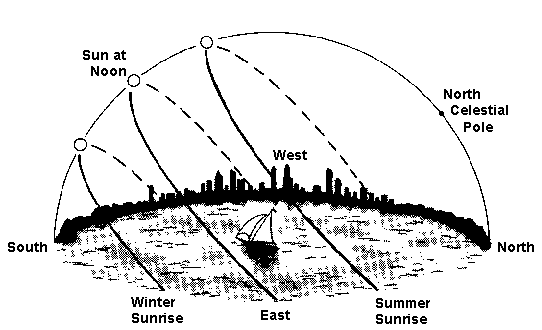
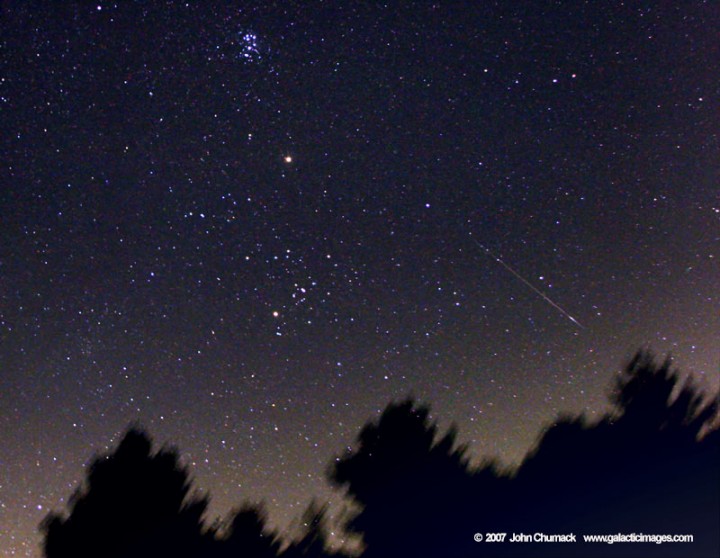








No comments:
Post a Comment